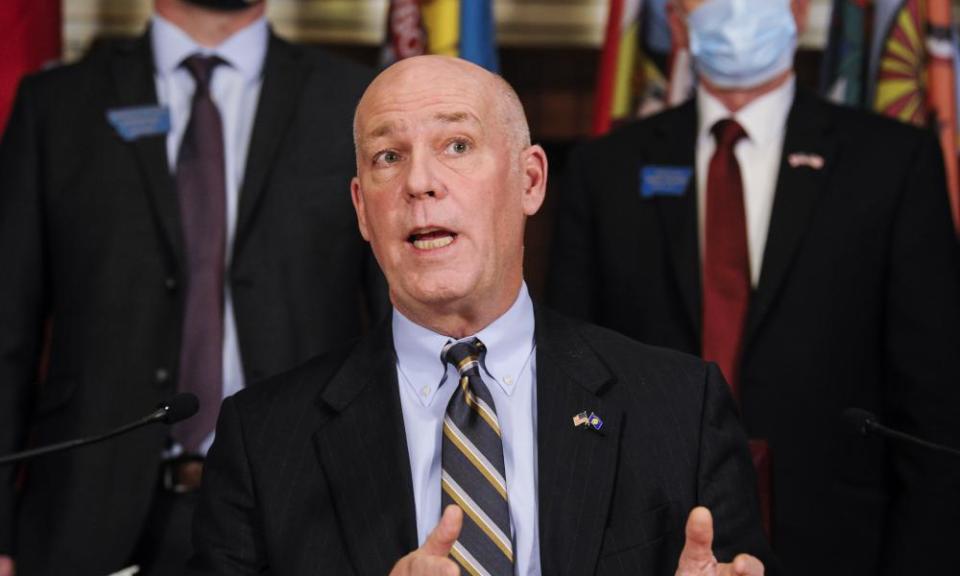Montana’s Republican governor pulls pandemic payments – is he for real?

The coronavirus pandemic – heard of it? It’s famously still going on! Though national case numbers are finally starting to drop and recent regional outbreaks in the midwest have begun to subside, there were still about 50,000 new Covid-19 infections recorded in the US on Tuesday and just over 700 new virus-related deaths.
But Greg Gianforte, Montana’s governor, has other priorities: he’s been talking about a “labor shortage” in a cynical attempt to cut public assistance. The Republican governor released a statement on Tuesday announcing his state will stop participating in the federal program that has given unemployed workers additional unemployment payments since the start of the pandemic – in an apparent attempt to get Montanans back to work, and he plans to give those who choose to do so something he calls a “return-to-work bonus”.
Here’s why it won’t work:
The “return-to-work” bonus is not a replacement for added unemployment benefits.
Thanks to the additional unemployment payments of $300 per week, out-of-work Montana residents receiving assistance currently get between $351 and $810 weekly, in enhanced unemployment benefits. Gianforte’s new plan will cut out those additional payments starting 27 June, and “incentivize Montanans to re-enter the workforce” with a single “return-to-work” bonus of $1,200 after one full month of work.
Now, I’m no high-falutin’ big city math-e-ma-tician, but a one-time payment of $1,200, which will only go to the first 12,500 workers to claim it – a tactic which, by the way, has huge “while supplies last!!” vibes – simply does not compare to $300 a week for the duration of the pandemic, ie, the foreseeable future.
Who knows how long that could be? Only about a third of Montana residents are vaccinated, according to the New York Times, and infections have risen approximately 8% over the past 14 days. The pandemic is not over yet.
What could “labor shortage” be another term for?
Although Montana’s unemployment rate fell to 3.8% in April, which is about at pre-pandemic levels, the state’s labor commissioner Laurie Esau says its labor force is approximately 10,000 workers smaller than it was pre-lockdown, a drop that Gianforte assumes is to do with lazy people who, given their new found pandemic benefits, don’t want to work any more. And according to Montana Department of Labor estimates, nearly 25,000 people are currently filing unemployment claims, a good chunk of whom the governor is eager to push into the state’s 14,000 or so job openings.
But this means there aren’t enough job openings for the number of people unemployed; even if the governor’s plan succeeds in filling those vacant positions as intended, there will still be over 10,000 people without jobs to apply for, forced to subsist on less. It is also wildly reductive to assume that because there are less people working, it must be the result of a lack of will. People had jobs, and those jobs were taken away, either through mass layoffs or government shutdowns of businesses. That kind of disruption takes time to recover from. People could now be working out childcare arrangements again; finding out where they fit in a new jobs market; or worried about returning to work until the coast is clear.
Workers also aren’t to blame for making more on unemployment than they would at their jobs.
The basis of the governor’s claims are that enhanced unemployment benefits have incentivized out-of-work Montana residents to stay unemployed. He says that the extra $300-a-week payments are now “doing more harm than good,” which is a strange way to view an intervention that is hopefully keeping people housed, clothed, and fed, but OK, sir! You’re the governor!
But let’s analyze the logic of whether benefits that make your life livable stop people from wanting to work. Last year, a study by economists at Yale found the enhanced unemployment pay authorized by Congress did not disincentivize Americans from seeking employment. And if “a bunch of Yale economists” aren’t convincing enough, how about labor secretary Mary Walsh, who told the AP that there’s no evidence of Gianforte’s claims to the contrary.
Even if there are some people choosing to stay home rather than go back to work because their enhanced unemployment benefits pay them more than their jobs (which again, no proof that that’s happening!), the argument that the alternative is preferable should be reconsidered.
Full-time workers earning minimum wage in Montana earn about $346 per week – far less than MIT estimates an average single Montanan needs to live. For those living with children, even the enhanced unemployment benefits wouldn’t cut it.
Nearly two-thirds of Americans have been living paycheck-to-paycheck since the pandemic hit stateside. So if I were a governor and wanted to, say, prevent an already-mounting housing crisis from mounting any further, want to give my residents enough to live on. But maybe that’s far too simple.

 Yahoo Finance
Yahoo Finance 